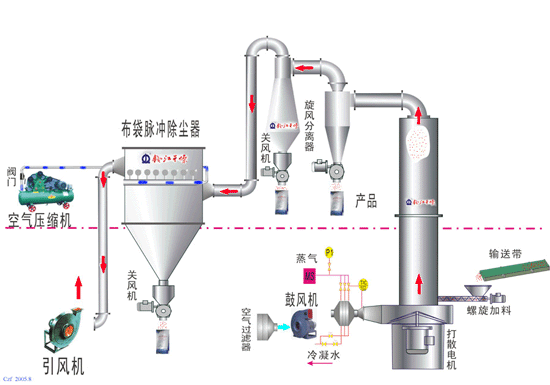The flash dryer mainly consists of an air intake system, heating system, feeding system, drying main unit, collection and dust removal system, exhaust system, and control system. During operation, the wet material is fed into the drying chamber by a screw feeder. In the drying chamber, the material encounters high-speed rotating hot air. The fine powder material is carried by the hot air to the upper part of the drying chamber, while the material that cannot be carried away falls to the bottom of the drying chamber. The material is then crushed by the bottom pulverizing device, rapidly dispersed, and the contact area between the material and the hot air is quickly increased. Under the action of centrifugal force (with a grading device at the top), products that have reached the drying degree and certain fineness are blown out of the grading device, and the material undergoes rapid drying in this process.
In recent years, China's titanium dioxide industry has seen several times growth in terms of capacity, output, and market demand, ushering in a period of prosperity for the titanium dioxide industry.
Titanium dioxide is considered one of the best-performing white pigments in the world, widely used in industries such as coatings, plastics, paper, printing, inks, chemical fibers, rubber, and cosmetics. Titanium dioxide has stable chemical properties and generally does not react with most substances under normal conditions. There are three crystalline forms of titanium dioxide in nature: brookite, anatase, and rutile. The coatings industry is the largest user of titanium dioxide, especially rutile titanium dioxide, with most of it consumed by the coatings industry. Coatings made with titanium dioxide have bright colors, strong coloring power, use less amount, and come in various types. They provide protection to the medium, enhance the mechanical strength and adhesion of the paint film, prevent cracks, resist ultraviolet rays and moisture penetration, and extend the life of the paint film.
The plastics industry is the second-largest user. Adding titanium dioxide to plastics can improve the heat resistance, light resistance, and weather resistance of plastic products, enhancing the physical and chemical properties of plastic products, improving their mechanical strength, and extending their service life.
The paper industry is the third-largest user of titanium dioxide. As a paper filler, it is mainly used in high-grade paper and thin paper. Adding titanium dioxide to paper provides good whiteness, gloss, high strength, thinness, smoothness, and prevents penetration during printing, resulting in light weight. Paper-making titanium dioxide generally uses untreated anatase titanium dioxide, which acts as a fluorescent whitening agent to enhance the whiteness of the paper. However, laminated paper requires surface-treated rutile titanium dioxide to meet light and heat resistance requirements.
Titanium dioxide is also an indispensable white pigment in high-grade inks. Inks containing titanium dioxide are durable and colorfast, with good surface wetting and easy dispersion. The ink industry uses both rutile and anatase types of titanium dioxide.
The textile and chemical fiber industry is another important application area for titanium dioxide. Titanium dioxide for chemical fibers is mainly used as a matting agent. Since anatase is softer than rutile, anatase is generally used. Chemical fiber titanium dioxide usually does not require surface treatment, but certain special types need surface treatment to reduce the photochemical activity of titanium dioxide and prevent fiber degradation due to the photocatalytic action of titanium dioxide.
The enamel industry is an important application area for titanium dioxide. Enamel-grade titanium dioxide has high purity, good whiteness, bright color, uniform particle size, strong refractive index, and high decolorization power. It has strong opacity and opacity, making the coating thin, smooth, and highly acid-resistant. It can be easily mixed with other materials in the enamel manufacturing process without agglomeration and easy to fuse.
The ceramic industry is also an important application area for titanium dioxide. Ceramic-grade titanium dioxide has high purity, uniform particle size, high refractive index, excellent high-temperature resistance, maintaining its color under 1200°C for one hour, high opacity, thin coating, and light weight. It is widely used in ceramics, construction, decoration, and other materials.
There are two methods for manufacturing titanium dioxide: the sulfate process and the chloride process. Among them, 56% are chloride process products, with over 70% of these products produced by major manufacturers like DuPont in the United States. Other countries, including China's titanium dioxide factories, mainly use the sulfate process.
Sulfate Process: The sulfate process involves acidifying titaniferous ore with concentrated sulfuric acid to produce ferrous sulfate, which is hydrolyzed to form metatitanic acid, then calcined and crushed to obtain titanium dioxide products. This method can produce both anatase and rutile titanium dioxide. The advantages of the sulfate process are that it can use cheap and readily available ilmenite and sulfuric acid as raw materials, the technology is relatively mature, equipment is simple, and corrosion-resistant materials are easy to solve. The disadvantages are the long process, mainly batch operation, wet operation, high consumption of sulfuric acid and water, many waste products and by-products, and significant environmental pollution.
Chloride Process: The chloride process involves mixing rutile or high-titanium slag with coke and performing high-temperature chlorination to produce titanium tetrachloride, which is then oxidized at high temperatures, followed by water filtration, washing, drying, and sealing to obtain titanium dioxide products. The chloride process can only produce rutile products. The advantages of the chloride process are a short process, easy expansion of production capacity, high degree of continuous automation, relatively low energy consumption, fewer "three wastes," and the ability to produce high-quality products.
Based on the material characteristics of titanium dioxide, our company has successfully applied independently developed dryers in titanium dioxide drying by digesting and absorbing advanced foreign equipment and technology.
闪蒸干燥机具有科技含量高,标准化高,环保、安全,低耗,维修简单等优点,在设计结构上:
①干燥器底部设置倒锥形体结构,使干燥气体流通截面自下而上逐渐扩大,底部气流相对较大,上部气流相对较小,从而保证下部的大颗粒处于流化状态的同时,上部的小颗粒也处于流化状态,并使热风沿椎体部旋转,提高底部风速,缩小了搅拌轴悬臂部分的长度,增加了运转的安全可靠性;可使轴承放在机外,有效防止轴承在高温区工作,从而延长了轴承的使用寿命。
②搅拌齿上设置刮板,物料在被搅拌齿粉碎的同时,又被抛向机壁,黏结在壁面上,如不及时刮下,严重时会使设备振动,甚至导致搅拌器闷住不转。搅拌齿上设置刮板,可以及时剥落黏在机壁上的物料,避免黏壁。
③搅拌轴的转数由无级调速电机控制。根据产品粒度要求选择不同的转速,搅拌轴转速越快,所的产品的粒度就越小。
④干燥器上部设置分级器,通过改变分级器的孔直径和分级段的高度,进而改变空气流速,控制离开干燥器的粒子尺寸和数量、^终含水量及物料在干燥段内的停留时间。
⑤加料机的螺旋输送机转数由无机调速电机控制。根据物料性质和干燥工艺参数控制加料速度。
⑥设备结构紧凑,占地面积小,集干燥、粉碎、分级为一体,是旋流技术、流化技术、喷动技术及对流技术的有机结合,干燥后不需要再粉碎、筛分,简化了生产工艺,节省了动力和设备费用。

